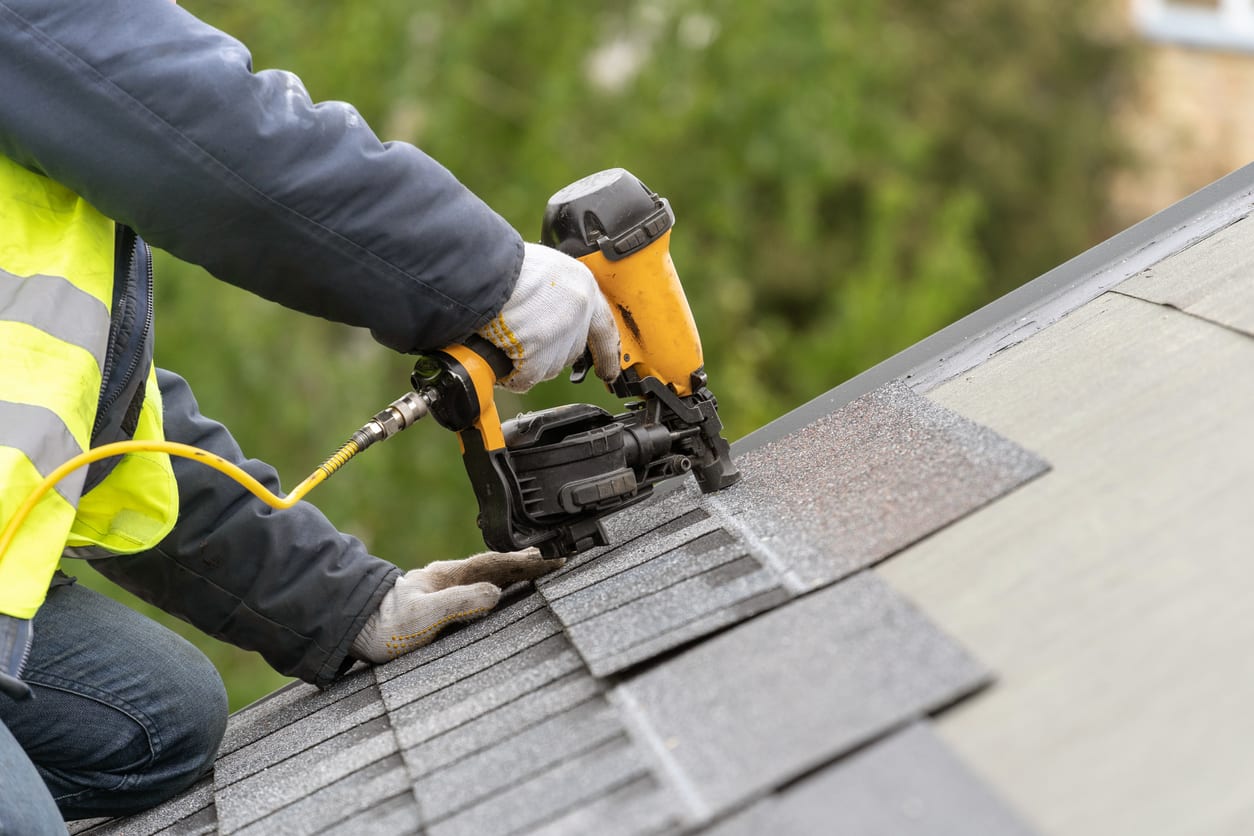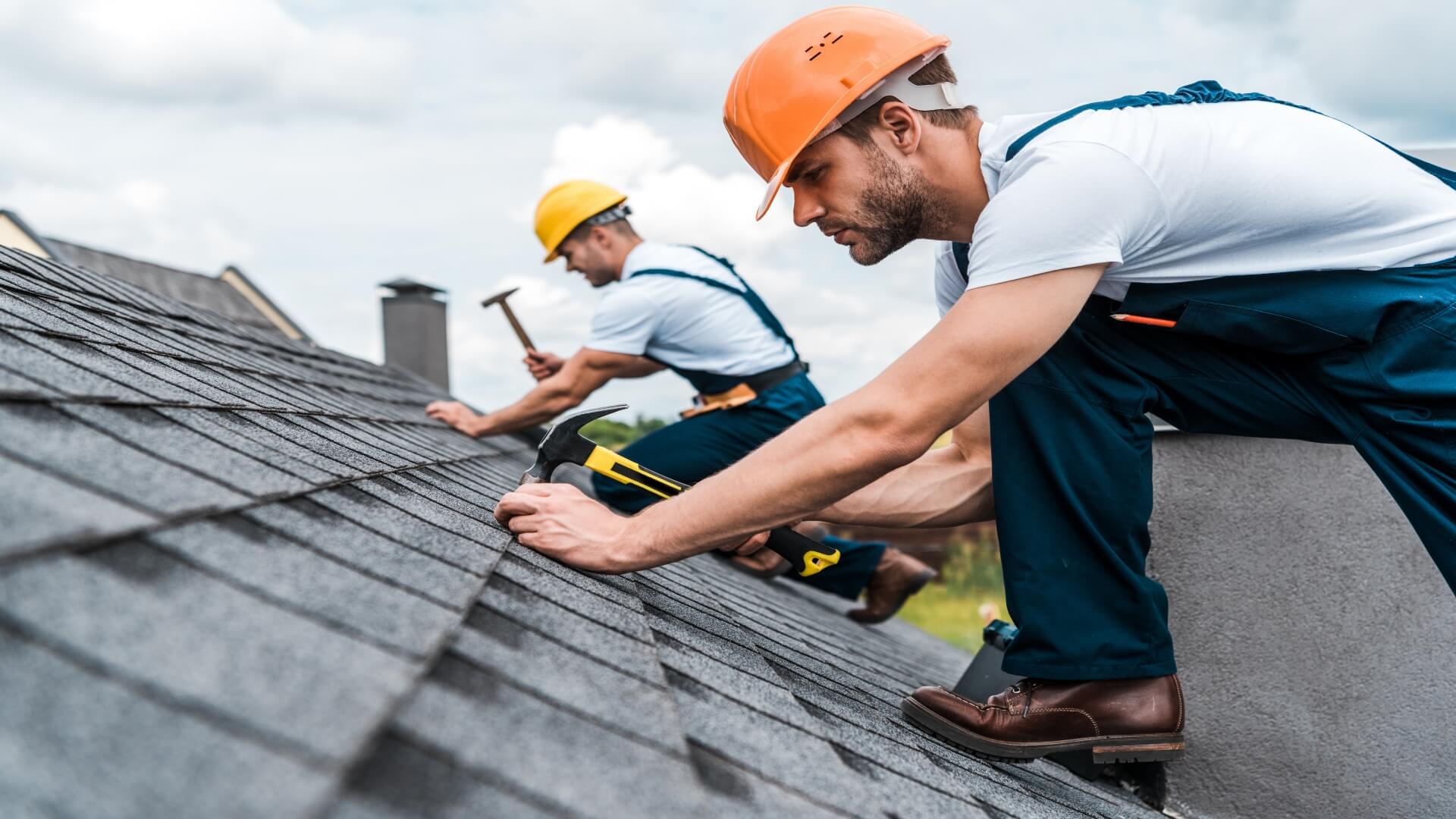Do It Yourself Roof Repair Work: A Step-by-Step Guide to Repairing Common Issues
You can deal with common roof problems yourself by starting with a detailed assessment for noticeable damage like missing out on shingles or sagging areas. Spot leakages by securing flashing and changing damaged tiles. Routine checks aid protect against costly repairs.
 roof repair
roof repairAssessing Your Roof Covering for Damage
Prior to you climb onto your roof covering, it's important to check it from the ground to recognize any visible indications of damages. Look for missing roof shingles, curled edges, or staining that may show leakages.
Next, check your seamless gutters for granules from shingles or standing water, both of which can indicate roof covering issues. These can be signs of water damages connected to your roofing system. if you find any spots on ceilings or wall surfaces inside your home.
Do not fail to remember to examine blinking around chimneys and vents, as harmed flashing can bring about leakages. If you notice anything worrying, it's finest to resolve it promptly to stay clear of much more extensive repair work later. Always focus on security, and don't be reluctant to call a professional if required.
Collecting the Required Tools and Materials
Before you start your roof covering repair, you require to collect the right tools and materials. Recognizing what vital tools you'll need, creating a list of needed products, and focusing on safety and security gear will set you up for success. Allow's review what you'll require to tackle this task efficiently and safely.
 roof repair
roof repairImportant Tools Summary
A strong roofing repair starts with the right devices and materials at your side. To tackle common concerns efficiently, you'll require a few essential tools. First, grab a sturdy ladder to safely access your roofing. A roof covering hammer or a nail gun will certainly help you secure tiles or other products. Do not forget an utility blade for reducing roof covering products properly.
Safety and security equipment is essential too; a set of work gloves and safety goggles will secure you from sharp sides and particles. A measuring tape assurances precise measurements while a crowbar aids remove harmed tiles. With these devices in hand, you'll prepare to take care of numerous roof repair work with confidence.
Required Products Checklist
With your tools all set, it's time to collect the products needed for your roof covering repair. First, examine your roof shingles. If they're damaged, buy matching substitute roof shingles. You'll additionally require roof covering nails, a strong adhesive, and a sealant to assure every little thing keeps leak-proof. Don't neglect a tarp or roofing paper to shield revealed locations while you function. If you're dealing with leaks, consider purchasing a water resistant membrane layer. For flashing repair work, buy brand-new blinking materials that fit your roof covering type. Get a pail or container for any type of debris you'll eliminate. Having all these products available will certainly make your repair work process smoother and more reliable, so you can finish the job right.
Security Equipment Relevance
While you may be enthusiastic to start your roof covering repair, do not forget the value of safety and security gear. Putting on the best tools can prevent significant injuries and ensure you work effectively. Begin with a strong helmet to shield your head from dropping particles. Non-slip shoes are essential for preserving grip on the roofing's surface. Do not fail to remember handwear covers; they'll maintain your hands secure from sharp tools and products. Safety and security safety glasses will certainly shield your eyes from dirt and particles. A harness is a must if your roof is high or steep, preventing drops. Lastly, a first-aid set ought to always be on hand for small injuries. Prioritizing safety equipment establishes you up for a successful and protected repair service job.
Covering Roof Leaks
When you discover a leakage, the first step is recognizing its source to assure an effective spot. You'll need to choose the ideal products for an enduring fix as soon as you identify the trouble. We'll walk you through the very best application strategies to secure those leakages and protect your home.
Determining Leak Sources
Exactly how do you identify the resource of a roof covering leak? Begin by examining your roofing system for visible damages or wear. Try to find cracked tiles, missing out on go to link ceramic tiles, or rusted blinking. Examine the locations around vents, skylights, and smokeshafts, as these are common leak areas. Climb up to your roofing and visually scan for any type of irregularities if it's risk-free. After heavy rain, go within your attic room or upper floorings to search for water stains or drips. Make use of a flashlight to help you see better in dark areas. If you can't find the source, take into consideration making use of a garden tube to simulate rainfall, section by area, up until you determine where the water gets in. This method can help tighten down the leak's beginning.
Selecting Patch Materials
Choosing the appropriate spot products is important for efficiently repairing a roof covering leakage. For level roofings, utilize a specialized patching material made for that surface.
Always make particular the materials are compatible with your existing roof to assure a durable solution. Likewise, check the weather; some materials require cozy or completely dry temperatures to stick effectively. Pick premium items to stay clear of frequent repair services down the line. By choosing the right products, you'll establish on your own up for an effective patching task.
Application Techniques Described
Applying patch materials properly is essential for securing roof covering leaks and preventing further damage. This ensures a strong bond in between the spot and the roofing surface area. Next, cut your patch material to fit over the harmed area, extending it at the very least 2 inches past the sides of the leakage.
Changing Damaged Shingles
When you discover damaged shingles on your roof, it's important to deal with the concern quickly to avoid further leaks and structural damage. Begin by gathering your devices: a crowbar, hammer, roofing nails, and replacement roof shingles that match your existing ones. Initially, thoroughly lift the harmed tile with your lever to eliminate it without disturbing the bordering roof shingles. Evaluate the location under for any indications of damage once it's free. If every little thing looks excellent, slide the new shingle right into place, straightening it with the others. Protect it with nails, making sure to comply with the manufacturer's guidelines for placement. Bear in mind to cover the nail heads with a little roof covering concrete to assure appropriate securing. Step back and check your work to validate a smooth appearance. With these quick actions, you can efficiently change broken tiles and keep your roof covering's stability.
Cleaning Up and Preserving Seamless Gutters
To keep your roofing in leading condition, routinely cleansing and preserving your gutters is vital. Clogged gutters can lead to water damage, mold and mildew growth, and also architectural problems.
Next, flush your gutters with a yard pipe to assure water flows freely. Look for leaks or corrosion spots while you go to it. Consider applying a sealer or replacing damaged sections. if you notice any kind of concerns.
To avoid future obstructions, set up gutter guards or screens, and make it a habit to clean your gutters at the very least twice a year, particularly before heavy rains or snow. Regular upkeep not only prolongs the life of your rain gutters however likewise secures your whole roof system.
Sealing Roof Covering Vents and Flashing
Securing roof covering vents and flashing is necessary for avoiding leakages and protecting your home from water damages. Start by checking the locations around your roofing system vents and blinking for any type of gaps or cracks.
Apply the sealer generously, filling all voids and fractures, after that smooth it out with your finger or a caulking tool for a cool finish. Make certain the sealer prolongs somewhat beyond the sides to develop a strong bond.
Permit the sealant to cure based on the maker's directions, generally a few hours or over night. After securing, it's an excellent idea to examine your work after a rainstorm to verify every little thing keeps leak-proof. Routine maintenance of your roofing vents and flashing can save you from expensive fixings down the line.
Fixing and evaluating Roof covering Valleys
Roof valleys are vital locations where 2 inclines meet, and they play an important role in guiding water away from your home. To examine your roofing valleys, start by climbing up securely and looking for indications of damage like loosened tiles, fractures, or debris.
For minor repairs, change damaged roof shingles and apply roof covering concrete to seal spaces. Taking care of roof valleys immediately will aid protect your home from water damages and prolong the life of your roofing.
Frequently Asked Inquiries
Just How Can I Identify if My Roofing System Requirements Substitute Rather Than Repair Service?
To identify if your roofing system requires substitute, look for substantial damage, sagging locations, or missing tiles. Think about replacement over repair service. if leakages linger in spite of fixings or it's nearing the end of its lifespan.
What Safety Safety Measures Should I Take While Fixing My Roofing?
When repairing your roof covering, constantly wear a safety and security harness and non-slip shoes. Make certain your ladder's steady, prevent functioning in negative weather, and have somebody nearby to help you in instance of emergency situations.
How Typically Should I Examine My Roof for Damage?
You need to check your roof covering at the very least two times a year, preferably in springtime and fall. After serious climate, check for damages also. Regular inspections can help you catch problems prior to they transform right into costly repair services.
Can I Repair My Roofing in Bad Weather Issues?
You shouldn't try roofing repairs in poor weather condition. Rainfall, snow, or strong winds can increase threats and complicate the procedure. Wait for clear conditions to ensure your safety and security and achieve a correct fixing.
What Should I Do if I Come across Wildlife in My Attic During Services?
If you run into wild animals in your attic room during repairs, stop quickly. Safeguard the area, avoid startling the pets, and get in touch with a professional wild animals removal solution to securely manage the situation prior to continuing your job.
Before you start your roof repair, you need to collect the right tools and materials.A solid roof covering repair service begins with the right devices and materials at your side.With your tools ready, it's time to gather the products required for your roofing repair work.Picking the ideal patch materials is vital for successfully repairing a roof leakage. Taking treatment of roof covering valleys promptly will aid secure your home from water damages and prolong the life of your roof covering.